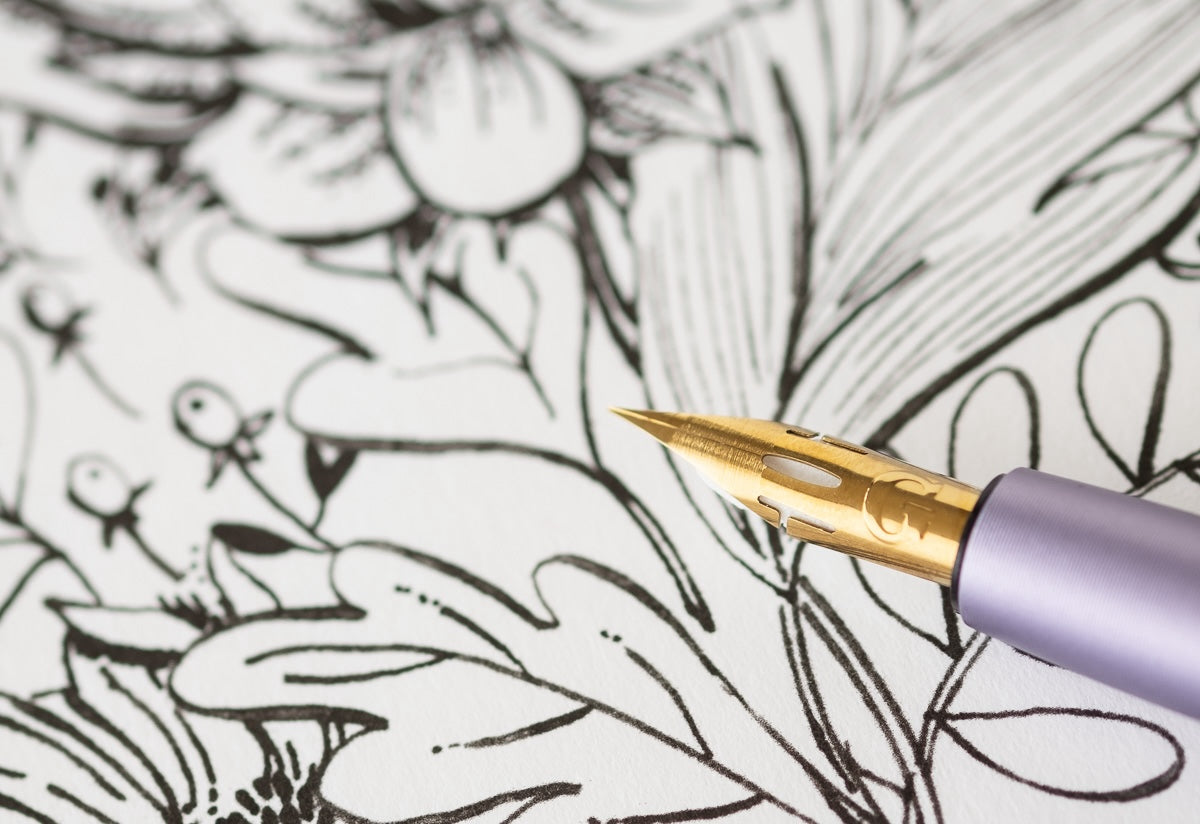Pro-Flex Nib
A brief guide to get you started with this professional grade fountain pen nib.

ABOUT THE PRO-FLEX
Made to work in all Tom’s Studio fountain pens, the housing is a Bock 250 size 6 which is common to lots of lovely tools.
The Pro-Flex is fitted with a Titanium Coated Zebra G calligraphy nib. This is the cream of the crop when it comes to calligraphy nibs and gives you the finest of fine strokes and the juiciest of thicker strokes – it flexes from a hairline to 2mm.
This beauty has a Japanese ebonite (a special type of vulcanised rubber) feed that delivers just the right amount of ink.
ALL ABOUT INKS
When using this nib in our Studio Fountain Pen, first assemble all the parts, then remove the pen body. Dip the nib into the ink bottle and twist the converter to draw ink into the barrel. Repeat this process until the barrel is full.
After filling, hold the pen nib upwards, tap the converter to remove any bubbles, and twist the converter to push ink into the feed until you see a small pool of ink at the bottom of the feed. Then, twist back slightly.
As you’re using it with a fountain pen, we’d advise any ink from our Fountain Pen Ink range.
CARING FOR YOUR PRO-FLEX
The Pro-Flex has higher maintenance levels compared to the other nibs as you’ll need to clean and dry your nib in between use, just like you would a regular dip pen – to prevent corrosion and prolong your nib's life.
Before using your brand new pen, you will need to remove the nib, clean off any residual manufacturing oil with soapy water, let dry completely and reinstall it into the housing.
When installing your nib for the first time, you will need to clean it before use.
Remove the nib from the housing and feed, clean off any residual manufacturing oil, dry it thoroughly, and then reinstall it.
When installing the nib into your pen, ensure that the feed (white), housing (black), and nib (gold) components are properly aligned. Even slight misalignment can disrupt the ink flow.
Check that the nib is perfectly centred on top of the feed. When viewed from the side, you should be able to see through the gap in the feed, with the nib not covering it more on one side than the other.
When inserting the nib and feed into the housing, ensure that the flat side of the housing aligns with the flat side of the feed.
Push the feed and nib securely into the housing (you may need to apply more pressure than expected).
Most fountain pen nibs are made from Stainless Steel which is super resistant to corrosion but is also hard as nails. Calligraphy nibs are made from softer, springier alloys, which allow them to flex with very little pressure. The tradeoff is that they corrode over time. However, the Titanium coating protects the nib and makes it last up to 6x longer than a standard nib. Once your nib eventually does bite the dust, you can remove it with pliers and replace it with a new nib available here.
One trick to getting the most from any flex nib is good contact between the feed and the nib. One of the clever things about ebonite is that it becomes malleable with heat, meaning you can achieve super cosy fit for optimum ink flow. This process is called heat setting and I do it to every nib, but it can occasionally need re-doing if the pen is knocked etc. I'll be making a video to demonstrate this but a quick google will also give you a good number of explanations and videos demonstrating the process. If you're not confident about this I would recommend the Semi-Flex nib instead.
TROUBLE SHOOTING
The hairline nib when unflexed creates beautifully fine strokes but, particularly if you're new to calligraphy, you will notice that it may sometimes snag on paper simply because it is so fine. For this reason we recommend using high quality paper with a smooth finish such as Bristol Board.
A very frustrating feature of eye-dropper pens is that they on occasion suffer from something called 'ink burping' (very unpleasant). This is a mystery, the greatest minds are still trying to decipher but it can mean that ink hungry nibs like the Pro-Flex can be affected by inconsistent ink flow. If this happens it may be worth reverting to an ink cartridge or convertor.
This is a very juicy nib, which is amazing when it comes to performance but can on occasion cause the nib to leak when you're not intending it to. If this happens, just remove the cartridge or convertor before travelling or storing.
